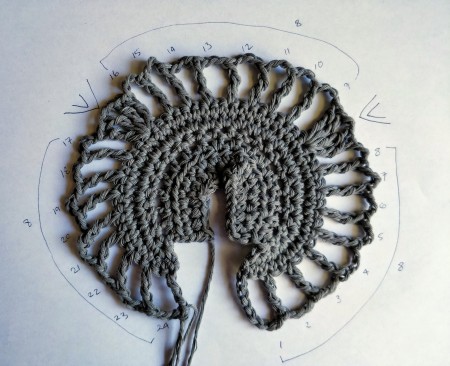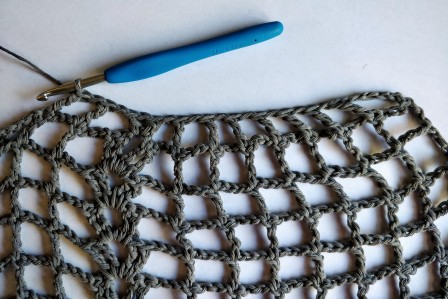This pattern was inspired by the French Market Bag Pattern by Alexandra Tavel, and since I’m a proud Frankston resident I thought why not call it the Frankston Market Bag. My pattern is worked all in one piece without the need for cutting and rejoining. I’ve also added a simple fan motif to break up the monotony of the netting section, and gathered in my sides more than Alexandra’s original pattern.
Notes
- This pattern is written in US crochet terms (see here for the UK version)
- I’d recommend this pattern for intermediate (or at least ‘advanced beginner’) crocheters. I’ve written this pattern with step by step instructions with the intention that beginners could complete it, but it does include some techniques that are more advanced, eg the foundation single crochet (FSC) stitch. An alternative to FSC is suggested for beginners.
- Hints or extra information is provided in italics
- The stitch count is provided in square brackets [..] at the end of each row
- You can add the pattern to your Ravelry queue here
- A print friendly version of this pattern is available to purchase from my Etsy store here for $1.99 AUD. Your purchase helps support my work as a designer. You will get 2 pdf downloads – a 7 page photo tutorial, plus a 2 page text only version. This short version is handy to refer to once you’ve made the pattern a couple of times and don’t need the photos.
Materials:
- 190-250 m (~80-125 g) of any 8 ply (DK) cotton [205-275 yards, 2.8-4.4 oz]. I used 206 m, 125 g of Industrial Yarns 1.5 mm cotton
- 5 mm/H crochet hook (or size required to get the gauge)
- Yarn needle, scissors, tape measure
Finished Size:
- Width at opening – 38 cm (15 in)
- Length (not including straps) – 30 cm (12 in)
- Straps – 38 x 2 cm (15 x 1 in)
Gauge:
Although the gauge is not critical for a bag, if your tension is very different to mine your bag may end up a lot smaller or bigger (which could cause you to run out of yarn), so this is here for your reference. Note that the gauge was measured on the finished bag without stretching.
- On the netting – 4 x 4 squares = 10 x 10 cm
- On the straps – 15 SC = 10 cm
Stitches (US terms)
- Ch = chain
- DC = double crochet (UK treble)
- Double V-stitch = (2 TR, ch 2, 2 TR) in the same stitch
- FSC = Foundation single crochet tutorial
- HDC = half double crochet (UK half treble)
- SC = single crochet (UK double crochet)
- SC2tog = single crochet two together
- SC3tog = SC three together
- Sl st = slip stitch
- TR = treble stitch (UK double treble)
Pattern
The pattern is worked back and forth, turning the work after each row. You will start by making a gathered section and then the netting which is 24 x 24 squares. Then work the second gathered section. Finishing with the border and straps which are worked in a continuous loop.
video tutorial for the start of the bag
Row 1: ch 18, HDC in the second chain from hook, HDC in each st to end [17 HDC]
Row 2: ch 1, HDC in each st [17 HDC]
Row 3: repeat row 2 [17 HDC]
Row 4: ch 1, 2 SC in first st, *SC in next st, 2 SC in next st* repeat between *..* [26 SC]
Row 5: ch 1, 2 SC in each st, end with 3 SC in the last st [53 SC]
Row 6: ch 1, SC in each st [53 SC]
Note: it’s going to look quite curly after this row (as shown in next photo). Don’t worry it will sort itself out after a few more rows.

Row 7: ch 7 [counts as first TR + ch 3 throughout], (skip 1 st* and TR into the next st, ch 3)x7; skip 2 sts and make a double V-stitch [= 2xTR, ch 2, 2xTR] in the next st, ch 3, skip 2 sts and TR in the next st; (ch 3, skip 1 st and TR into the next st)x6; ch 3, skip 2 sts and double V-stitch in next st; ch 3, skip 2 sts and TR in the next st; (ch 3, skip 1 st and TR into next st)x7 [23 TR, and 2 double V-stitch]
*note that the first treble will be worked into the 3rd stitch of row 6, as the ch 7 is counted as a TR in the 1st stitch


Row 8: ch 7, *(TR into the top of the TR in the previous row, ch 3)x7; double V-stitch into the ch 2 gap of the double V stitch in the previous row, ch 3* repeat *…* 2 times; (TR into the top of the TR in the previous row, ch 3)x7, at the end of the row work a TR into the 4th ch of the previous row’s starting ch 7 [23 TR, and 2 double V-stitch]


From row 8 – 30 you will be working into the top of the TRs or into the ch 2 gap in the double V-stitch
Rows 9-29: Repeat row 8 [23 rows of netting in total, counting from row 7]
Note that it will look curved at first, but straighten out as you make more rows

video tutorial for row 30 onward:
Row 30: Ch 5 (counts as first TR + Ch 1), *(TR into the top of the TR in the previous row, ch 1)x7; (DC, ch 1, DC) into the ch 2 gap of the double V stitch in the previous row, ch 1* repeat *…* 2 times; (TR into the top of the TR in the previous row, ch 1)x7, work a TR into the 4th chain of the previous row’s starting ch 7 [23 TR + 4 DC + 26 ch = 53 sts in total]

Row 31: ch 1, SC in each stitch (TR, DC and ch) from row 30 [53 SC]
Row 32: Ch 1, SC2tog x 25, SC3tog [26 sts] *Note, you will have 3 stitches left at the end of the row, hence the SC3tog
Row 33: ch 1, SC2tog, *SC in next stitch, SC2tog* repeat to end [17 sts]
Row 34: ch 1 , HDC in each st [17 HDC]
Rows 35-36: Repeat row 34 [gives a total 3 rows of 17 HDC]

End of row 36. ***Note: check that the width of rows 34-36 match rows 1-3, adjust tension if required.
In the next row you will start working in a continuous loop around the sides of the netting (gathering them in) and forming the straps
Row 37: A. ch 1, make a single SC into the side of each row of the gathered section [6 SC]. When you get to the netting part, do 2 SC into each square [48 SC]. For the gathered section at the other end, do one SC in the side of each row [6 SC].
***In the next step you will start to form the first handle using a foundation SC stitch (FSC). If you’ve never done FSC before, check out this video before you start. NB I prefer the FSC compared to making a long chain and then working SC into it in the next round, since you already have the height of a SC after the first round. You can simply do a chain if you prefer, but you will then need to add an extra row of SC after row 39. NB – these straps are designed to be long enough to go over your shoulder (~40 cm), if you prefer to carry the bag in your hand, I’d recommend making shorter straps of 30-40 FSC (or chains).***
37 B. make an FSC chain of 60 (see photos on next page and following instructions for starting and ending the FSC chain)
for the first FSC: pull up a loop through the top of the HDC at the end of the gathered section, yo, pull up a loop, yo and pull through 2 loops
on the 60th FSC: insert hook in base of previous st, yo and pull up a loop; insert hook into the top HDC where you will join back to the bag, yo and pull loop through the hdc and first loop on hook; yo and pull through both loops left on hook to complete the FSC [60 FSC]
37 C. Continue with SC in the side of each row of the gathered section [6 SC] and finish second side of bag and handle as for step 37 A and B. Finish with a sl st to the first SC of step A [row 1 of border complete – 240 sts in total]
Row 38: ch 1, SC in each of the first 6 sts; on the netting part: SC2tog x 24, SC in each of the next 72 sts (gathered part and handle), on the netting again: SC2tog x 24, SC in each of the next 66 sts, join with sl st [row 2 of border – 192 SC]
Row 39: ch 1, SC in each st, join with sl st. cut yarn and sew in end [row 3 of border -192 SC]
NOTE: if you used a chain instead of FSC at row 37, add an extra row of SC before cutting the yarn to make sure you have 3 rows of SC on the handles.






Beautiful. Wonderfui instructions
LikeLike
Thanks Judy!
LikeLike
Excellent Instructions
LikeLike
Very nice bag. I also commented on the youtube tutorials, but I really enjoyed making this bag. It worked up quick, and I’ve already used it shopping. I made a bunch of Plarn out of old plastic bags, and used that to make my market bag. I derive a great deal of joy from the concept of making reuseable shopping bags out of disposable bags.
LikeLike
Beautiful bag and wonderful instructions.
LikeLike
Wow! Thank you so much for adding your fabulous video for making the Frankston Market Bag. Your instructions were easy to follow along with and with the written pattern I accomplished a lovely bag. Thank you thank you!❤️
LikeLike
Just made a mini version using up some thin cotton yarn I had in my stash, it’s the perfect size for fruit and veggies!
LikeLike